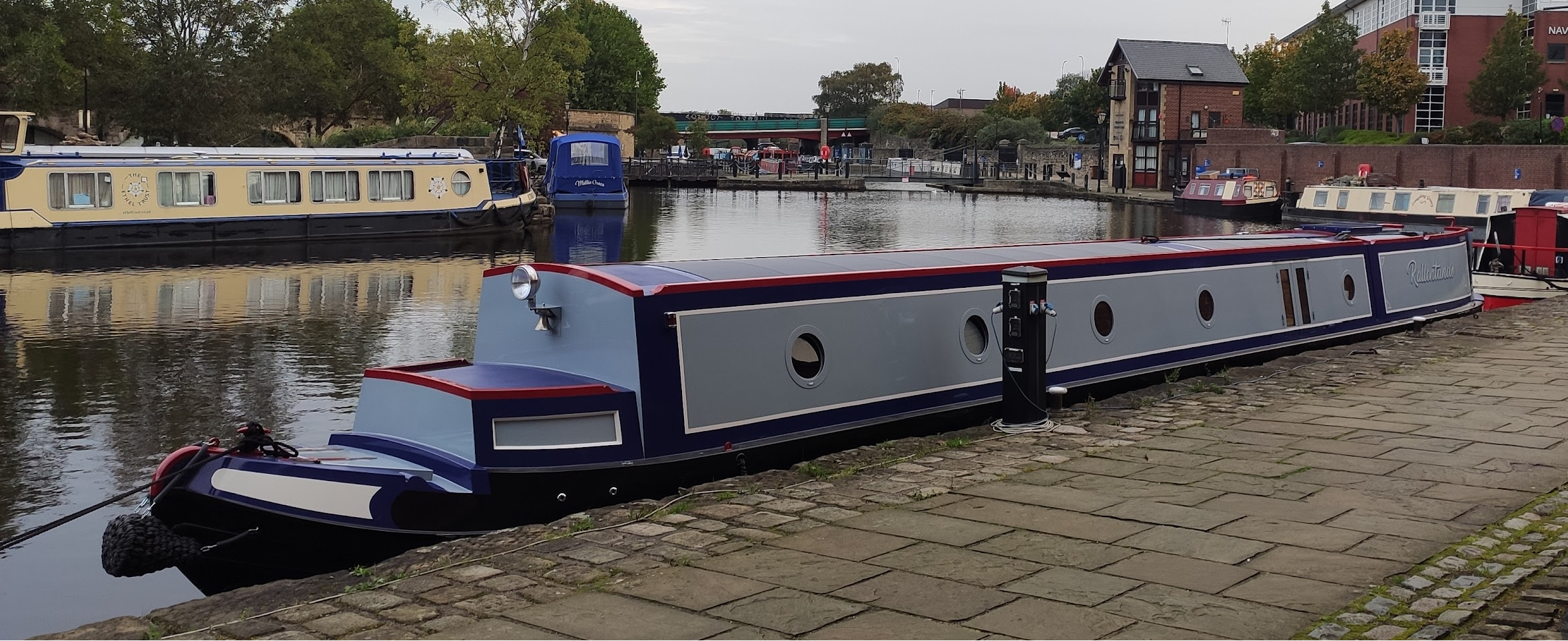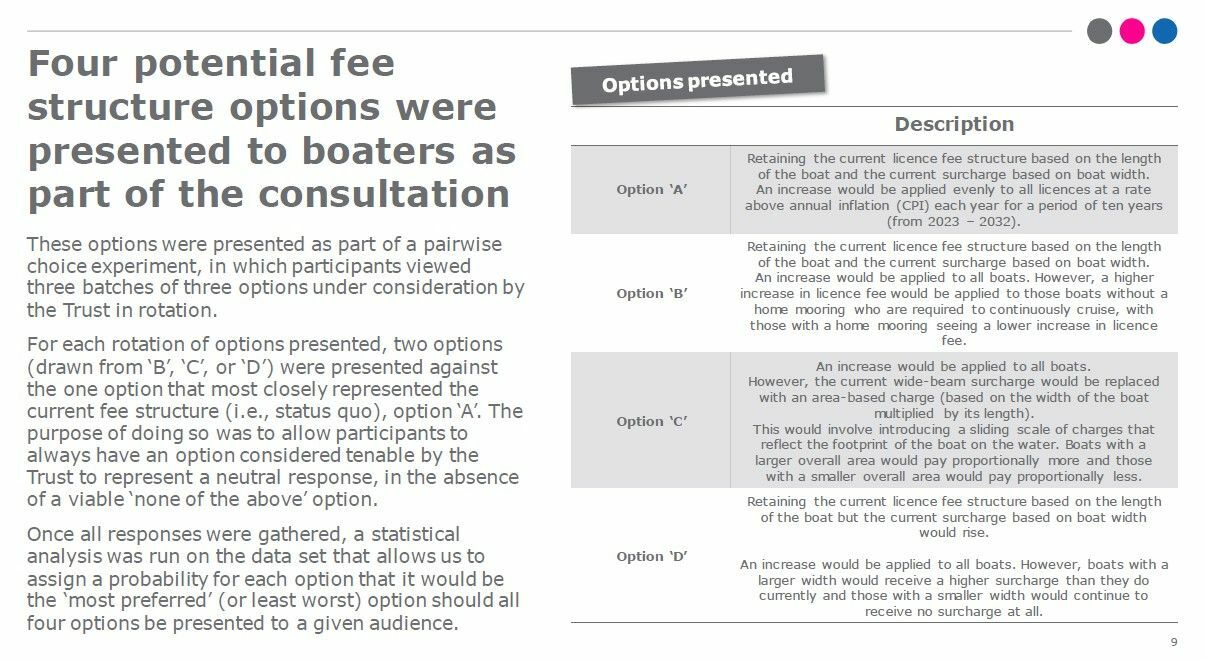-
Posts
11,379 -
Joined
-
Last visited
-
Days Won
89
Content Type
Profiles
Forums
Events
Gallery
Blogs
Store
Everything posted by IanD
-
Hence 40% for the CC surcharge being chosen. Though 46% were in favour of widebeams paying more (C and D combined) which is why CART chose the more popular of the two ways of doing this. The status quo (flat increase) was clearly (14%) the loser, no matter how many times people keep trying to say it wan't... 😉 The results show how all boaters voted vs. Ccers and HMers. Wideboat owners were not shown separately, maybe because the data wasn't available? Certainly the CCer/HMer split on the CC surcharge shows that many boaters were voting in their own interest, as expected.
-
Difficult to see how that's the case, given that it didn't mention amounts anywhere... The main point wasn't "do you agree with an increase?" either, since it's always been made clear the the license fee was going up. The point was *how* should the increase -- however big -- be done and which boaters should pay more (or not), and the results were pretty clear. CCers (and wideboat owners) may not be happy with the result, but it's what boaters said they wanted -- or as CART said both beforehand and in the results, what boaters disliked the least... 😉
-
About 20hp then, assuming your boat isn't overpropped... 😉
-
You mean it stops aggrieved boaters claiming "CART fiddled the results!!!" or "CART just did what they'd already decided!!!" ? Because this thread suggests it didn't work... 😉
-
It's explained in the snapshots how this was done -- boaters were offered three batches of three options (chosen from the four) to choose from, each of which included the status quo (option A) and two others (chosen from B/C/D), then the results were combined -- so the three sets would be ABC, ACD, and ABD. It's a standard method of analysis when trying to find out what people prefer given more than two options, including the status quo, because it avoids forcing people to choose an option when they don't like *any* of the new choices, and also asking people to choose one of 4 options doesn't reflect what they actually prefer -- there are loads of textbooks on statistics and polls and data analysis explaining why this would have been done, I haven't read one since the late 1970s but I might still have one in a box in the attic... As the results showed, 40% of all boaters preferred the CC surcharge, made up from 49% of HMers and 3% of CCers, hardly a surprising result. The next least unpopular result was an increased widebeam surcharge. The least popular choice of all was the status quo (flat increase for all boaters). The CCer vote was pretty much a 3-way split between the status quo and each of the two methods of making wideboats pay more, again hardly surprising. CART are doing what boaters said they wanted (or disliked the least), as far as I can see there's no evidence behind the claim that they'd made the decision in advance other than conspiracy theories -- for example I'm pretty sure CART would have favoured area-based pricing because it would have brought them in more money, but that was clearly a bit less popular than an increased widebeam surcharge so they chose that instead. Arthur's right that "real CCers" (as opposed to CMers) may have got caught in the fallout caused by bad feeling towards the p*ss-takers, but the fact remains that CCers contribute less to CART income than HMers (via mooring levies) and the +25% CC surcharge largely corrects this -- so CCers crying out "it's not fair!" are kind of missing the point... 😉
-

Proposed new accessible electric narrowboat.
IanD replied to Andrew Grainger's topic in New to Boating?
1kW while cruising is a ludicrously optimistic number put forward by a company trying to sell electric boats, the only way to use that little is to travel everywhere at a crawl like you'd normally pass moored boats... 😉 There's plenty of data from people who actually have such boats -- including me and several others on the forum, and the Ortomarine trial -- showing that something like 3kW (about 1kWh/mile) is much more realistic when cruising on the open canals (not passing boats or in locks) at normal narrowboat speed, which also agrees with estimates of diesel boat power used at typical rpm. Could be a bit lower (2kW?) or higher (4kW?) depending on your exact speed and canal width/depth, but certainly not 1kW -- to give an idea, that would be around 900rpm on a typical Beta 43 installation. The more time you spend passing moored boats the lower power use will be, but it doesn't make as much difference to kWh/mile as you think (though it does to average energy used over a day, as do locks). Say you spend 4 hours at 3kW/3mph, that's 12 miles using 12kWh. Then 2 hours passing moored boats at 1kW/2mph, that's 4 miles using 2kWh. Then 2 hours in locks, that's 0 miles using 0kW. Total used in an 8 hour day is 14kWh (1.75kW average power) to travel 16 miles at an average of 2mph while averaging 0.9kWh/mile. Based on this, a 35kWh LFP battery like mine (80% SoC used) would give about 2 days of cruising (32 miles) without a recharge. Of course this ignores solar power but also domestic power use, how these balance out depends on appliance use and time of year. IIRC there was a spirited debate with one of the guys from mothership on CWDF a couple of years ago when he promoted those figures -- which have been repeated by gullible journalists in more than one article! -- and was told by multiple people they were far too optimistic, and when he couldn't defend them he threw his toys out of the pram and went home... 😉 You should read the Ortomarine report which has a lot of real data gathered on multiple boats, both electric/hybrid and diesel. https://www.ortomarine.co.uk/ortomarines-electric-narrowboat-performance-trials-event-final-report/- 392 replies
-
- 2
-

-
- electric
- insulation
-
(and 2 more)
Tagged with:
-
Actually there were four proposals, and even more people rejected proposal A for a flat fee rise than any of the others, didn't they? CART said before the survey that they wanted fo find out what the least unpopular ways to raise license fees were, in the knowledge that none would be popular because people don't want to pay more. Now they've implemented the two least unpopular ones (CC and increased wideboat surcharge) and not the two most unpopular ones (area-based charging and a flat fee increase). So what exactly are you complaining about?
-

Proposed new accessible electric narrowboat.
IanD replied to Andrew Grainger's topic in New to Boating?
Thermal storage can help, a well insulated calorifier (mine has double the normal insulation thickness) does this to some extent. A much bigger thermal store like some have on wideboats would help more, but fitting them in on a narrowboat is difficult. But neither this nor a marginal improvement in insulation (e.g. ludicrously expensive aerogel blanket vs. sprayfoam) is going to fix the fundamental problem with trying to avoid "burning stuff" on an electric narrowboat, which is energy demand exceeding renewable energy supply... 😞- 392 replies
-
- electric
- insulation
-
(and 2 more)
Tagged with:
-

Proposed new accessible electric narrowboat.
IanD replied to Andrew Grainger's topic in New to Boating?
You don't have to disconnect the shore lead when you're using a lot of power, the inverter will take the maximum shoreline current set (e.g. 16A) and the rest will come from the batteries. But it does typically take twice as long to recharge from shoreline as it does from the generator. Not an issue if you're plugged in overnight, but there's no equivalent to the EV fast chargers. There are a few 32A points but these still take hours for a full charge, like using the generator.- 392 replies
-
- 1
-

-
- electric
- insulation
-
(and 2 more)
Tagged with:
-

Proposed new accessible electric narrowboat.
IanD replied to Andrew Grainger's topic in New to Boating?
The LFP battery on my boat is 35kWh, I've run it from 100% SoC down to 10% once when the genny stopped working due to water in the diesel and I had to get to a boatyard. 0.33miles per kWh makes no sense, I found I was cruising at about 3mph on 3-4kW which is getting on for 3x better than this (1 mile per kWh).- 392 replies
-
- 1
-

-
- electric
- insulation
-
(and 2 more)
Tagged with:
-

Proposed new accessible electric narrowboat.
IanD replied to Andrew Grainger's topic in New to Boating?
Given the size of the boat and the amount of solar that can be fitted on, it's unlikely to work even in summer with an all-electric boat including cooking and propulsion, given that the OP also wants to be able to cruise around. And without an onboard generator or fuel-based heating, it'll be completely unusable outside the summer months unless plugged into shoreline in a marina. A full-length electric-only boat with maybe double the solar would be more usable in summer and still OK for a couple of months in spring and autumn, but still unusable in winter. A "Passivhaus" works, a "Passivnarrowboat" doesn't... 😞- 392 replies
-
- electric
- insulation
-
(and 2 more)
Tagged with:
-
And regardless of how many boaters didn't like the offered surcharging options, even more didn't like a flat fee rise which you seem to favour. You keep ignoring this, but it's still true. The reason is undoubtedly that CCers and wideboat owners are heavily outnumbered so HMers amd narrowboat owners think they should pay more, and this was made clear in the report. But the majority winning is how votes and elections should work in a democracy, isn't it?
-

Proposed new accessible electric narrowboat.
IanD replied to Andrew Grainger's topic in New to Boating?
But the OP especially wanted to be eco-friendly (zero emissions and pollution) and not burn stuff... 😉 Not gonna happen though, all the things that make this possible with an eco-house simply don't work on a narrowboat... 😞- 392 replies
-
- electric
- insulation
-
(and 2 more)
Tagged with:
-

Proposed new accessible electric narrowboat.
IanD replied to Andrew Grainger's topic in New to Boating?
Great film. Inefficient steamers use enormous quantities of fuel though, ask @DHutch, so not very eco-friendly are they? And if they burn loads of wood, that also means truly massive PM2.5 emissions... 😞- 392 replies
-
- electric
- insulation
-
(and 2 more)
Tagged with:
-
This post cannot be displayed because it is in a forum which requires at least 10 posts to view.
-

Proposed new accessible electric narrowboat.
IanD replied to Andrew Grainger's topic in New to Boating?
I'd say the opposite -- being off-grid, fossil-free and not burning stuff is *way* easier in a suitably-built house than on a boat, especially a narrowboat. Far easier to insulate and keep warm (e.g. Passivhaus), far easier to get lots of solar on the roof, far easier to use a heat pump (air or ground source). Nothing wrong with trying to do it on a boat, but the numbers are heavily stacked against you without *some* energy source like HVO -- unless you're plugged in and in a marina all the time, which isn't really boating... 😉- 392 replies
-
- electric
- insulation
-
(and 2 more)
Tagged with:
-
This post cannot be displayed because it is in a forum which requires at least 10 posts to view.
-

Proposed new accessible electric narrowboat.
IanD replied to Andrew Grainger's topic in New to Boating?
Which is where I'd like to go, if only HVO was easily available on the canals -- which it might be in future, but isn't right now... 😞 Still means "burning stuff" though, with a generator and CH boiler fuelled by HVO, which was what the OP was trying to avoid -- but realistically can't... 😉- 392 replies
-
- electric
- insulation
-
(and 2 more)
Tagged with:
-

Proposed new accessible electric narrowboat.
IanD replied to Andrew Grainger's topic in New to Boating?
Narrowboat double-glazing will be nowhere near as good as household, the space between the panes is much smaller and the frames are less well insulated even with a thermal break. You'd need at least two of those heatpumps for a narrowboat, and possibly three -- note that they'll be less efficient when it's cold outside (measured at +7C) which is when you really need them for heating. And I don't think those noise levels count as "silent", similar ones I've heard make a fair bit of noise especially on full power -- which again, is what you need when it's cold. And the problem remains that -- like the Frigomar marine one I mentioned -- they consume about 1kW when they're running, which would be a lot of the time when it's cold, so at least 10kWh/day and could be double that when it's really cold. You're not going to get this power from solar panels even in summer (maybe 5kWh/day average on a 45' boat) and almost nothing in winter (<<1kWh/day) so where is the power going to come from? Not to mention what you'll need to run the other appliances on board, including electric cooking if you go gas-free. Idle power consumption of everything on an all-electric boat like mine (including inverter, MPPTs, DC-DC, Cerbo, router...) is typically around 100W (2.4kWh/day) when moored/plugged-in *and doing nothing* like it is now, and you have to add whatever energy you use when on board (cooking, fridge, lights, TV, laptop, washer, kettle, toaster, microwave...) on top of this. Even if you're not moving at all, this could easily double the energy use, obviously this depends on what you do but another 100W average isn't that much. So solar in summer will just about keep up with domestic power use and a bit of cruising, depending on size of boat -- your problem is that a 45' narrowboat has limited roof space, about half what a full-length boat has. In winter, no chance. Unless you spend most of your time plugged in with battery bank power used for short cruises (up to 2 days?) or only use the boat in summer and don't move much, you're going to need an onboard generator, which means burning fuel. That's not just me saying that, it's the finding of pretty much everyone with an electric/hybrid boat.- 392 replies
-
- electric
- insulation
-
(and 2 more)
Tagged with:
-
This post cannot be displayed because it is in a forum which requires at least 10 posts to view.
-
This post cannot be displayed because it is in a forum which requires at least 10 posts to view.
-

Proposed new accessible electric narrowboat.
IanD replied to Andrew Grainger's topic in New to Boating?
IIRC my boat is 6'1"/185cm wide internally (not onboard so can't measure it), and has a couple of inches of sprayfoam insulation. As you say there are other less-well-insulated areas like floor, portholes/windows, and then there are draughts through the free-air ventilation required by BSS regulations -- so halving the heat conduction through the walls/roof won't halve the energy needed to keep the boat warm. The basic problem is that narrowboats are smaller/longer/thinner (bigger surface/volume ratio) and more poorly insulated than houses, have great difficulty using heat pumps, don't have as much roof area for solar panels, and aren't always plugged in to (partly-renewable) mains power -- and none of this is going to change any time soon, or indeed ever. Which means that though it is perfectly possible to live in a well-designed house without burning anything, it's not possible on a narrowboat out on the cut except in restricted circumstances (e.g. summer, not cruising much, in a marina), and certainly not all year round unless plugged in.- 392 replies
-
- electric
- insulation
-
(and 2 more)
Tagged with:
-
This post cannot be displayed because it is in a forum which requires at least 10 posts to view.
-
This post cannot be displayed because it is in a forum which requires at least 10 posts to view.




